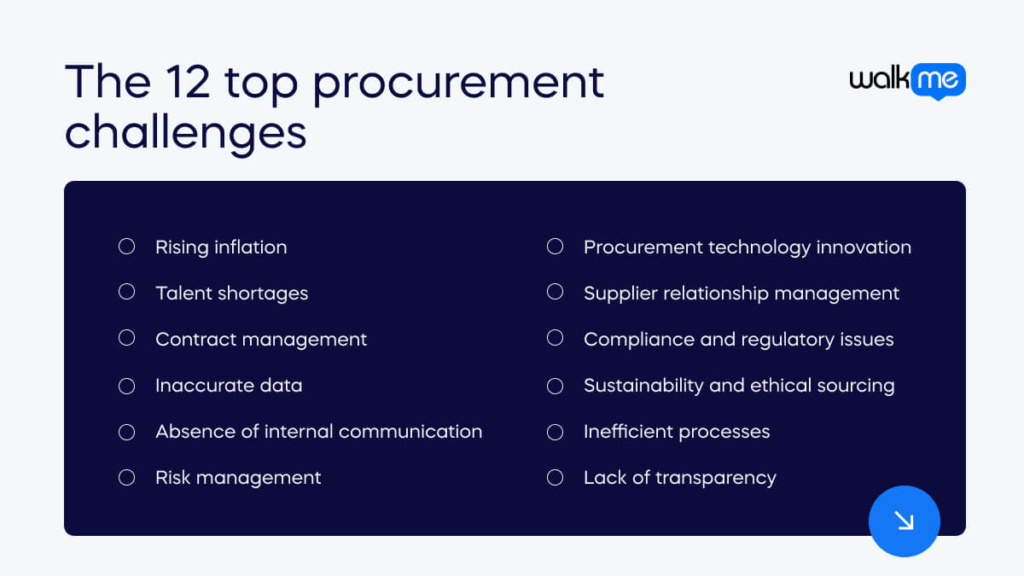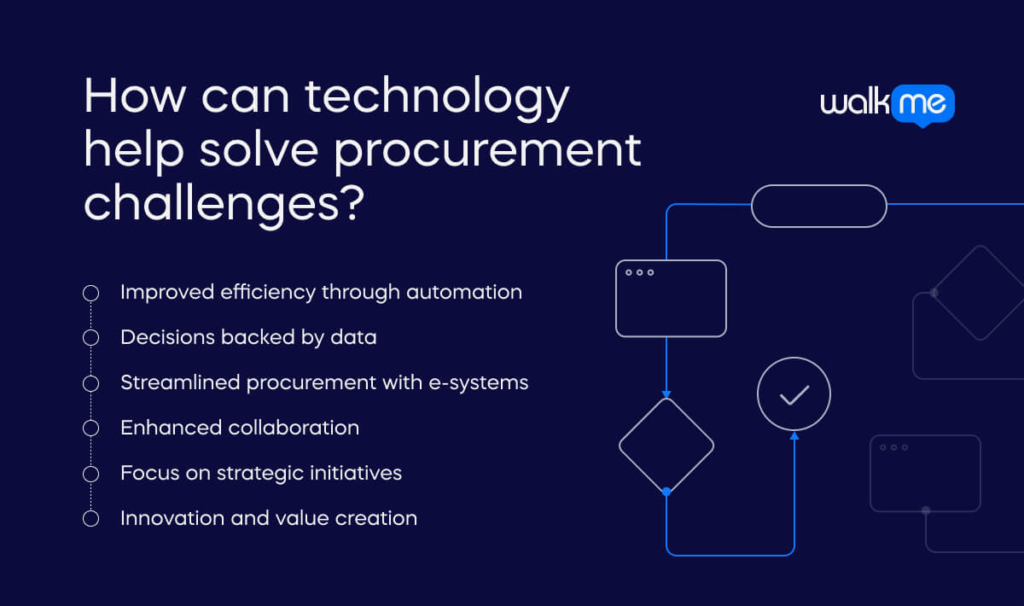Procurement is the process of getting the goods and services your company needs. It’s critical for success, but it’s also complex.
Procurement teams work closely with internal departments like finance and operations and a network of outside suppliers. Collaboration is key to successful procurement; everyone must work towards the same goals.
Even the best teams face challenges. The Hackett Group says their workload increased by over 10% last year. On top of that, there’s a shortage of procurement professionals, making it even tougher to keep up.
These hurdles can slow operations, drive costs, and cause digital disruptions.
This article will examine the top twelve procurement challenges that can threaten your business. We’ll also discuss how technology can help solve these challenges and provide key procurement tips to support your company’s success.
What are 12 of the top procurement challenges?

Procurement has come a long way in the last ten years. Spurred on by digital innovation, it has undergone a major digital transformation.
However, despite these advancements, procurement teams still face a number of hurdles. Avam Solutions says 86% of procurement leaders observed capability gaps in their teams.
Here are 12 of the top procurement challenges that can threaten success:
- Rising inflation
Rising inflation poses a major challenge for modern procurement. As the cost of goods and services increases, procurement teams face pressure to maintain profitability. This can lead to higher prices for consumers, squeezing budgets.
Businesses can combat inflation through several key strategies. Strategic negotiation tactics are crucial. Locking in prices with long-term contracts, exploring alternative suppliers, and negotiating volume discounts can all help mitigate rising costs.
Procurement teams can also reevaluate product specifications. Considering substitutions for materials or feature adjustments without sacrificing quality allows for cost savings without impacting functionality.
Data is another powerful tool. Tracking price trends and analytics helps businesses identify potential savings opportunities. It also pinpoints areas where inflation is hitting hardest.
Collaboration with suppliers is key. Partnering with suppliers to explore cost-saving innovations and identify joint efficiencies can lead to mutually beneficial solutions.
- Talent shortages
Talent shortages are a significant challenge for modern procurement. Finding and retaining skilled professionals is becoming increasingly difficult. This often leaves teams understaffed and overworked. It increases the risk of errors and hinders their ability to drive strategic value.
To combat this challenge, businesses must invest in training to develop existing employees. They should rethink their recruitment strategies by targeting diverse talent pools and offering flexible work arrangements. A positive, supportive work environment is crucial to attracting and retaining top talent.
Strategic outsourcing provides specialized expertise. And technology automates routine tasks, freeing up staff for more strategic activities.
- Contract management
Contract management can be a major headache for procurement. It’s too easy to get bogged down in complex terms and confusing clauses, leading to costly mistakes and damaged relationships.
World Commerce and Contracting says bad contract management can drain 9% of your company’s revenue. That’s a huge chunk of money just flying out the window. Businesses need clear, consistent processes to stay on top of their contracts. Simple language is key, as are templates whenever possible.
Technology can help track renewals, amendments, and key dates. Investing in contract management expertise (in-house or outsourced) is crucial for protection and peace of mind.
- Inaccurate data
Inaccurate data is a critical vulnerability for procurement teams. It undermines effective decision-making. This leads to missed opportunities, wasted resources, and even supply chain disruptions.
Consider the following scenario. Internally inaccurate inventory numbers can result in stockouts or excessive spending. And outdated supplier information can cause you to miss out on better deals.
Several actions are essential to ensure data accuracy and safeguard your bottom line. Regularly implementing data audits helps identify and rectify errors. Investing in data cleansing and management tools can further streamline the process.
Emphasizing the importance of accuracy and training your team on proper data entry procedures are crucial steps.
- Absence of internal communication
Procurement can’t operate in a silo. Without strong communication with finance, operations, and other departments, teams work blind. This leads to missed deadlines, duplicated efforts, and a whole lot of frustration.
To overcome these barriers, businesses need to prioritize communication. This means regular meetings with key stakeholders and clear channels for sharing information. This promotes a culture of collaboration across the organization.
Remember, procurement isn’t an island—open communication keeps everyone on the same page and drives success.
- Risk management
Procurement is full of risks. According to Forrester, 41% of organizations reported experiencing three or more critical risk events in the last 12 months.
Supply chain disruptions, price volatility, and regulatory changes wreck even the most meticulously planned procurement strategies. Without proactive risk management, businesses are exposed to costly surprises.
To navigate these uncertainties, companies need a robust risk management plan. This includes regularly assessing and identifying potential threats across the entire supply chain. Developing contingency plans to mitigate disruptions allows for a swift and effective response.
Building strong supplier relationships based on transparency and trust encourages open communication. This enables early identification of issues. Investment in technology for early detection of potential problems equips businesses to address challenges before they escalate.
- Procurement technology innovation
Getting the green light for new procurement tech is tough. IT resources are limited, and procurement often gets sidelined. To win the fight, you need a rock-solid business case showing exactly how the tech will boost the bottom line.
Don’t be afraid to challenge the status quo – sometimes, the best tech isn’t the easiest for IT to manage. And remember, enterprise technology buying can feel risky, but the cost of doing nothing could be even higher.
Choose solutions that solve real problems, are easy to use, and articulate the benefits for the entire organization.
- Supplier relationship management
Think of your suppliers as partners, not just vendors. Building strong relationships takes effort, but it pays off in big ways.
According to CIPS, over a third of firms don’t know how their suppliers perform. Lack of time, software, understaffing, and people forgetting were the main reasons for not evaluating suppliers.
Effective supplier management offers a trifecta of benefits. These include better prices, reliable supply, and even access to innovation.
To achieve these benefits, businesses must have a strong supplier relationship built on several key pillars. Open communication is essential. This promotes information sharing, collaborative problem-solving, and a willingness to address challenges.
Mutual trust is also important. Building a foundation of transparency and reliability allows businesses to forge long-term, mutually beneficial partnerships.
Collaboration on innovation unlocks a hidden advantage. Suppliers often possess a wealth of expertise and a unique perspective on the industry. By tapping into this resource, businesses can access new ideas and solutions, propelling them ahead of the curve.
- Compliance and regulatory issues
Ever-changing compliance and regulations are a constant thorn in the side of procurement teams. Navigation is a never-ending challenge. It involves everything from deciphering complex legalese to keeping pace with updates. The global nature of supply chains only adds to the complexity. It increases the risk of encountering different regulations and potential violations.
The key to overcoming these hurdles lies in a multi-pronged approach. It is crucial to equip your team with the necessary knowledge and tools. Technology can be a powerful ally—leverage procurement software with built-in compliance features. For particularly complex situations, consider partnering with legal or compliance specialists.
Collaborating with ethical suppliers and maintaining meticulous records can secure your supply chain and simplify compliance audits. This two-pronged approach ensures responsible sourcing while making it easier to demonstrate compliance.
- Sustainability and ethical sourcing
Sustainability and ethical sourcing aren’t just buzzwords. Customers demand them, investors expect them, and it’s the right thing to do.
However, building a responsible supply chain takes work. Start by getting to know your suppliers. Don’t just take their word for it – conduct audits, request certifications, and engage in open dialogue.
Embed sustainability into your contracts, set clear environmental and social performance expectations, and hold suppliers accountable. Collaborate with suppliers to identify and improve unsustainable practices, offering support and resources where needed.
Measure and communicate your progress on sustainability metrics, sharing your successes transparently with stakeholders. Building a sustainable and ethical supply chain is a journey, not a destination. Start by taking action, and keep driving continuous improvement.
- Inefficient processes
Inefficient processes are the saboteurs of procurement. Think of all those manual tasks, outdated systems, and unnecessary bottlenecks. They suck up time, waste resources, and create a breeding ground for errors.
Streamlining operations requires a deep dive into existing processes. Businesses can achieve this by embracing technology to automate repetitive tasks, allowing the team to focus on strategic initiatives. A critical analysis of each step within a process is also essential.
This analysis should question the purpose of each step. Then, identify opportunities for simplification or even elimination. Ensure a collaborative environment through improved communication across departments. This means everyone works towards the same goals.
- Lack of transparency
Imagine procurement shrouded in secrecy. Decisions are made behind closed doors, information is tightly controlled, and suppliers feel like they’re operating in the dark.
According to the Center for Strategic and International Studies (CSIS), a lack of transparency in procurement can be a major liability. It undermines supplier relationships, hampers efficiency, and can damage an organization’s reputation.
Transparency in procurement is no longer a luxury; it’s a necessity. To achieve transparency, businesses need a multi-pronged approach.
Sharing information readily with stakeholders, both internally and externally, fosters trust and collaboration. Ditching ambiguity is also crucial. Clear and standardized guidelines for every step in the process ensure everyone’s on the same page.
Procurement software is a time machine for transparency, providing real-time data and insights for informed decision-making.
Building trust with suppliers through open communication and collaboration creates a win-win situation for all involved. By embracing these practices, businesses can transform their procurement process into a crystal-clear window of transparency.
How can technology help solve procurement challenges?

Procurement faces major challenges, but technology offers a powerful toolkit for overcoming them.
Let’s dive into how it can revolutionize the way you do business:
Improved efficiency through automation
Manual tasks bog down procurement teams, wasting valuable time and resources. Automation takes over the tedious work of requisition approvals, PO creation, invoice matching, and even routine purchases. It eliminates bottlenecks and reduces errors. Imagine your team finally having the bandwidth to focus on high-impact strategic activities instead of the mundane grind.
Decisions backed by data
Relying on gut instinct is risky in procurement. With the right technology, you can access powerful analytics that transforms raw data into actionable recommendations. Visualize spending patterns, compare supplier performance metrics, and get alerts on potential savings opportunities. These insights help you make smarter, data-backed decisions that optimize costs and reduce risk.
Streamlined procurement with e-systems
Paper-based processes and scattered systems slow things down and open the door to errors. E-procurement solutions streamline everything by bringing the entire process online. Centralized platforms enable digital sourcing, contract management, ordering, and payments. This creates a faster, more transparent experience, with real-time visibility and audit trails for improved compliance.
Enhanced collaboration
Procurement often suffers from siloed information and miscommunication. Technology bridges these gaps. It enables seamless communication and data sharing between procurement, internal departments, and suppliers. This makes for better collaboration. It ensures everyone’s pulling in the same direction and builds trust across the supply chain.
Focus on strategic initiatives
When automation handles routine operations, your team can tackle big-picture initiatives, dedicate time to developing strong supplier relationships, explore innovative sourcing solutions, and proactively manage risks. Technology empowers procurement to evolve from a transactional function into a strategic value driver for the entire business.
Innovation and value creation
The best tech platforms don’t just save you time. They open doors to new possibilities. Advanced analytics, AI-powered tools, and predictive modeling can help you forecast disruptions, evaluate complex scenarios, and make proactive decisions. This lets you stay ahead of the curve. It also enables you to deliver greater value through innovative procurement strategies.
Powering procurement with digital adoption
Digital transformation in procurement means investing in the right tools and ensuring your team knows how to use them.
A specialized digital adoption platform (DAP) for procurement provides the essential bridge. Think of it as in-app guidance that tailors training and ongoing support for your team. This streamlines the adoption of new procurement software and helps you get the most out of your investment.
Using a DAP empowers your team with real-time assistance. It boosts their confidence and ensures proficiency within your chosen tech solution. This means faster results and reduced support costs.
Don’t let complex software slow your team down. A procurement-focused DAP unlocks its true power, helping you thrive in a digital environment.

